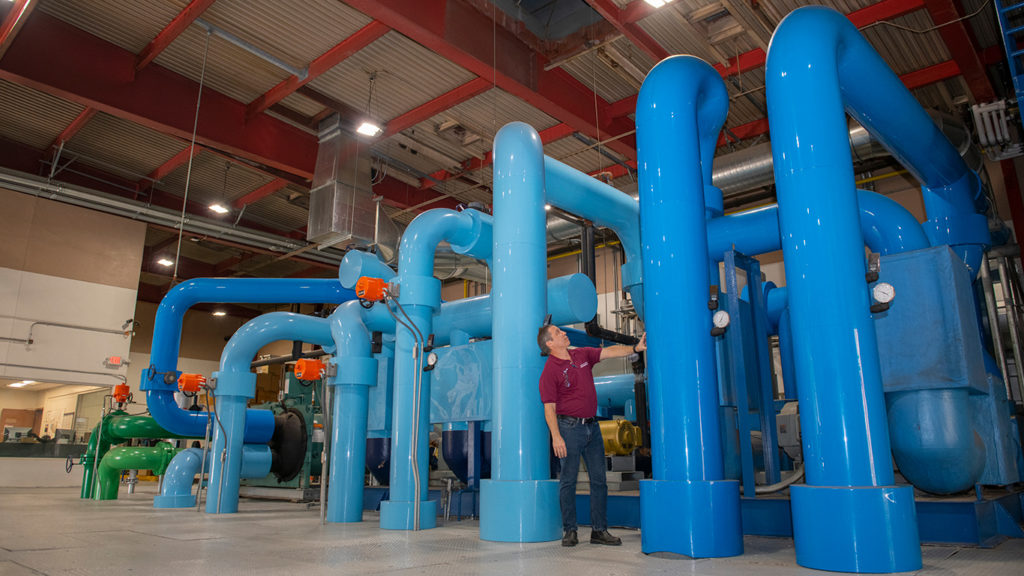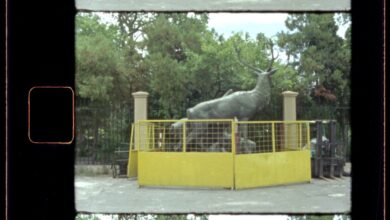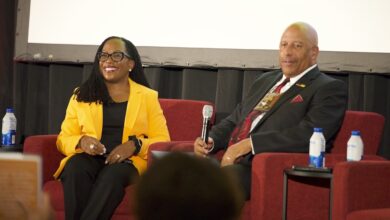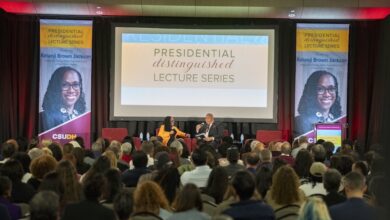
Source: Chronicle of Higher Education
California State University-Dominguez Hills started building on its current site in 1965, amid America’s postwar higher-education boom, and its campus looks like a lot of regional state universities: a core of Brutalist concrete buildings with glassy, modern structures surrounding them. This campus of 16,000 students is emblematic in another way – it’s racking up a mounting tab for deferred maintenance.
Administrators tally the deferred maintenance there at $130 million, and growing to $252 million over the next 10 years. In September last year, the California State University system requested $1.3 billion from the State of California to address the problem. In a January draft of the state budget, Cal State leaders got a sense of how much of that request the state would deliver: zero.
That $1.3 billion was just a fraction of the $5.8-billion backlog of repairs and renewals needed across its 23 institutions – an amount that grows by about $280 million a year. CSU-Dominguez Hills was relatively fortunate – it recently received about $1 million a year from the state to tackle priority projects across the campus. Still, that math doesn’t add up.
“We’re behind every year,” says Jonathan Scheffler, associate vice president for facilities management and operations. He and his staff have to get creative, finding money for projects through energy-saving partnerships with a local utility or incorporating infrastructure repairs with other projects. Much of what nags at Scheffler and his colleagues on the facilities staff are problems never seen by students and faculty, and they are not the parts of buildings that donors want to put a name on.
“In our buildings that were built in the ’70s – those are some of the core buildings – we have infrastructure issues,” he says. “You know, the electrical, the plumbing, the sewer, the storm-drain systems. We keep up on our roofing, but all those behind-the-wall type of systems are at or beyond their useful lives.” The switchgear that distribute electricity throughout the campus are from the founding of the institution.
“That’s the thing that keeps me up at night,” Scheffler says. “If we lose something like that, what do we do to replace it? How do we keep it going? Even getting electrical components nowadays, with the long lead times, is crazy.”
Dominguez Hills is an example of a problem plaguing higher education. Deferred maintenance – or as some call it, “deferred capital renewal” – has been a persistent worry for colleges, but a range of events and forces seem to be leading to an inflection point: Higher education may be reaching a stage where the backlog of needs on campuses becomes so overwhelming that it threatens the viability of many institutions and demands major action.
Consider that for 70 years, higher education has built like never before – and may never again. In the post-World War II years, colleges built up their campuses to accommodate an expanding national population and fundamental societal shift pushing college after high school. During the height of the Cold War and into the internet era, they built to serve an era of growing research and advancing technology, adding facilities for science and health care. More recently, they built to compete with a neighbor or peer – recreation facilities and residence halls to capture the attention of students, academic buildings to draw star faculty, and signature buildings to grab the attention of the media. And sometimes they built at the behest of a donor who wanted a name on something, or a president who wanted to point to an accomplishment before moving on to another college.
Building satisfied the needs of the time. College leaders often thought less about the unglamorous work of maintaining what they already had.
The result of all this building has been hundreds of millions of added square feet to college campuses, and much of that was predicated on future growth. But higher education’s growth years may be behind it for a while, with students falling out of the system during the pandemic and a long-predicted demographic downturn just on the horizon. (And even in the growth years, it’s not as though money was always there for repair and renewal, as organizations like the American Society of Civil Engineers have routinely noted the mediocre-to-failing condition of the nation’s infrastructure.)
Meanwhile, bricks, steel, concrete, and mortar follow the laws of entropy. As a rule, buildings have two critical stages in their lifetimes: At 25 years, a building needs significant updates and renovations; at 50, a major overhaul of its structure and systems. In recent decades, colleges went through two peaks of construction, one in the early 1970s and another in the late ’90s and early 2000s. Do the math: Two building life cycles will come due in the 2020s.
Lander Medlin, the president and chief executive of APPA, an association of higher-education facilities managers, points out that the construction costs of a building represent only about 25 percent of the total lifetime expenses. Recurring annual costs, like utilities, everyday maintenance, and operations, represent another 35 to 40 percent.
The rest is periodic costs in the lifecycle of essential building systems: replacing the roof after 50 years, updating the heating and cooling system after 20, the plumbing and wiring, the building’s skin, and more. “The forgotten costs are the periodic costs,” says Medlin. They are rarely calculated or allocated for at the beginning of a project. And the longevity of such systems is often affected by the attention to the recurring annual maintenance.
This week, Gordian, a company that tracks facilities’ conditions in higher education and advises colleges on strategy, released its 10th annual “State of Facilities in Higher Education,” a study of the facilities needs among the member institutions in Gordian’s portfolio. The capital-renewal needs at colleges, which had hovered around $100 per square foot in recent years, suddenly jumped up to $133 per square foot.
The recent spike in inflation in the economy has affected prices of building materials, accounting for some of that jump. But the report notes other long-term trends that have exacerbated the growing capital-renewal gap: For about a decade, space has grown while enrollment has been flat or declining at baccalaureate and master’s institutions, and capital spending has neither met campus-investment needs nor kept up with inflation.
And the report notes the headwinds and complications colleges face in addressing the problem: enrollment (and financial) challenges stemming from demographic trends; questions about the value of a college degree; public disinvestment in higher ed; and a shift to hybrid and online courses. Facilities workers themselves embody some of those challenges. For years, higher education has noted a graying of that work force, while younger workers in the trades have been hard to find and in high demand.
All of this may point to a new attitude about construction on campus.
“We’ve just been growing since the ’50s, assuming that there will be more and more students to come,” says Pete Zuraw, vice president for market strategy and development at Gordian. “The question is, do we need all the space we built? Can we learn to live with less?” That’s not a conversation that Americans are accustomed to, but in higher education in particular, it’s foreign. “There’s nobody on these campuses that ever lived at a time when there wasn’t this expansive kind of nature.”
The costs of deferred maintenance are piling up for institutions and systems both large and small.
In Vermont, colleges have closed and consolidated as the state has been among the first to feel a student-population dip. Deferred maintenance in the Vermont State Colleges system – $18 million in a small system – has grown 53 percent since 2017, compared to 37-percent growth among its peer institutions.
“We are overbuilt, really dramatically, in terms of academic spaces,” says Sharron Scott, the system’s chief financial and operating officer. Academic-space utilization is around 30 percent during regular business hours on its campuses. Ideally, it would be closer to 60 to 65 percent. Meanwhile, working from home has become more common across higher ed since the pandemic.
All of this means less need for space. The Vermont system’s square footage needs to shrink by up to 30 percent to be sustainable, says Scott.
In higher education, “growing is easy. Becoming smaller is hard,” says Scott. “There’s an axiom about making sure that you have a crane on campus when you have admissions days coming, because it’s exciting to see something new. No one wants to hear that your space should be smaller, because that appears like you’re giving up.”
Underutilized public buildings are white elephants in depopulated rural areas, says Scott, but the system is considering ways it could offer space to health-care systems or nonprofit organizations that could provide jobs or other services to students. The system might try to lease space to organizations through public-private partnerships. As a last resort, some buildings might be demolished, a move that can be costly in terms of remediating toxic substances – and in angering faculty or alumni with sentimental ties to the spaces.
At a much-larger university in a more-populous state, the backlog becomes a dizzying figure. The University of Minnesota-Twin Cities has a 10-year renewal need of $4.2 billion, with more than seven-million-gross square feet of space in poor or critical condition. (Facilities managers often frame the renewal need in terms of helping the institution plan to raise money and prepare for upcoming projects in the coming decade.) The university plans to manage that backlog by investing in critical, high-priority buildings and projects, and right-sizing the campus by offloading and demolishing less-important spaces.
But the university is never going to erase that $4.2-billion backlog. “I don’t know that we honestly catch up as much as we decide where we’re going to focus,” says Bill Paulus, associate vice president for facilities management at the University of Minnesota. “You pick your priorities and you go after those.”
The tough part is defining which projects are “critical,” he says. Is it putting in ramps and other accessibility features on a structure built before the Americans with Disabilities Act? Is it replacing old roofs and windows in a building that is leaking energy and wasting money? Is it installing new elevators that meet modern safety codes? Is it updating the classrooms to meet modern teaching styles and requirements?
On a campus with competing interests and limited resources, “somebody has to make this interpretation,” he says.
What makes the problem of deferred maintenance so troubling for higher education is the sector’s unusual relationship with its properties. Unlike many businesses and organizations, higher-education institutions typically construct and own most of their buildings. And unlike major real-estate businesses, colleges can’t sell off their buildings and move to another geographic location. When they build, they are binding themselves to a structure and a location for decades – and possibly centuries.
That permanence comes with obvious disadvantages – an institution can’t just walk away from a broken-down hulk – but also some opportunities. “You could say there is an advantage in that you can create long-term partnerships that others may not be able to do,” says Paulus. For example, a university can work out a multidecade deal with a local power company to create a local solar or wind farm, to lock in below-market electricity rates for years to come. “The stability can give you benefits both in confidence with your partnerships and your decision-making.”
ntering into partnerships is one strategy to find the resources for updating aging buildings. That’s what CSU-Dominguez Hills has done with Southern California Edison, the local utility. Kenneth Seeton, the university’s central plant manager, is constantly looking for companies or organizations that can offer Dominguez Hills money or components that will help with the maintenance and bottom line.
The university joined Edison’s Clean Energy Optimization Pilot, which granted it $1.2 million in 2021 with the goal of reducing greenhouse-gas emissions and saving energy. The university is in line to get another $2.4-million rebate check this year. The campus has been a leader in the system for greenhouse-gas reductions.
Through that partnership and others, the university has installed high-efficiency LED lighting, experimented with solar hot water, and replaced pneumatic components with digital controls in its heating and ventilation systems. Over the past few years, Dominguez Hills has reduced its energy use in many of its buildings by 50 percent, while also replacing old components.
“You have 30- and 40-year-old buildings that are still running with pneumatics, and it’s not running correctly,” says Seeton. “You can’t get parts for this stuff anymore.”
Efficiencies are where institutions can start to catch up, Seeton says – but delaying some of those upgrades costs money as time goes on. Seeton’s latest focus is getting off natural gas. The university had 20-year-old direct gas-fired absorption chillers, which make water cold by burning gas, and it replaced them with more efficient electrical units. Over the winter, because of global demand and the Russia-Ukraine war, gas prices tripled. The university’s gas bill went from $50,000 one month to $170,000 the next. It would have been $300,000 if the university hadn’t done work in improving its energy efficiency.
“We can’t continue running these buildings on 1970s technology, because it doesn’t work and it doesn’t give us the control that we need to be able to save – the energy that we have to save,” he says. “Now, it’s become an economic thing. It’s not just about making you happy in your space.”








